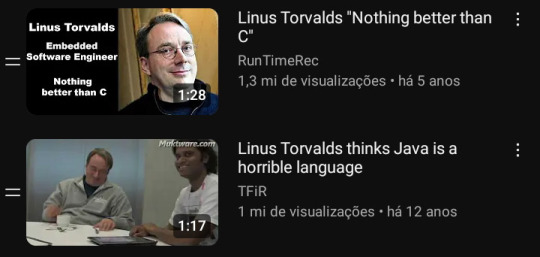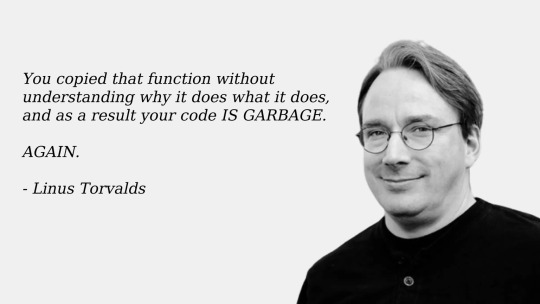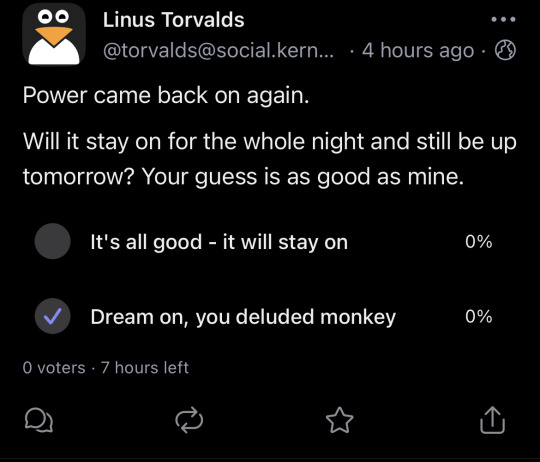#linus torvalds
Text

My love for Linus Torvalds (the creator of Linux) grows evermore.
via @[email protected]
874 notes
·
View notes
Text
Watching this TED talk interview with Linus Torvalds is absolutely hilarious because the host (in true phony tech bro fashion) keeps trying to bait him into talking about these grand dreams or sweeping ideas he had behind Linux and Linus is just like "I liked the thing. So I did the thing"
Host: But you had some dream, right?
Linus: No.
Host: Just a little dream?
Linus: No dream.
Host: But--
Linus: Did I mention I'm kind of a jerk?
Host:
Linus: (turning to a crowd full of tech nerds) Anyway, I like Edison better than Tesla
Absolute legend.
( Interview here: https://www.youtube.com/watch?v=o8NPllzkFhE )
131 notes
·
View notes
Text
When Linus Torvalds eventually dies, someone is going to draw (or have an AI draw) a cartoon of Tux the penguin crying in mourning to illustrate it.
Like this illustration of a crying Mickey-Mouse-globe, used to illustrate Walt Disney's death in 1966:

but with Tux the penguin.
35 notes
·
View notes
Quote
Talk is cheap. Show me the code.
Linus Torvalds
#Linus Torvalds#thepersonalwords#code#quotes#literature#life quotes#author quotes#prose#lit#spilled ink#writers on tumblr#writing inspiration#poets on tumblr
36 notes
·
View notes
Text

Apparently this didn't exist already, so you're all welcome.
23 notes
·
View notes
Quote
Talk is cheap. Show me the code.
Linus Torvalds
#Linus Torvalds#code#show#talk#talking#quotes#life quotes#quotelr#literature#authorquotes#author quotes#lit#poetry#prose#spilled ink
104 notes
·
View notes
Text

.
12 notes
·
View notes
Text

Linus to everyone using ChatGPT and copilot.
#linus torvalds#infotech#chatgpt#copilot#book quotes#quotes#quoteoftheday#book quote#life quote#beautiful quote#quote#quotable#information technology#i.t.#it#coding#coders#coder#a.i. generated#a.i.#artificial intelligence#ausgov#politas#auspol#tasgov#taspol#australia#fuck neoliberals#neoliberal capitalism#anthony albanese
8 notes
·
View notes
Text
Did you know?
The Linux kernel's reboot syscall accepts the birth dates of Torvalds and his three daughters (written in hexadecimal) as magic values. Why magic numbers? They needed to safeguard against a typo in the syscall number to avoid accidental reboot which can result into data loss. So he ended up using something he remembers well ;)

61 notes
·
View notes
Text

Linus Torvalds is posting on Mastodon again.
2 notes
·
View notes
Text


(context)
7 notes
·
View notes
Text
What is Linux?
From smartphones to cars, supercomputers and home appliances, home desktops to enterprise servers, the Linux operating system is everywhere.
Linux® is a family of open-source Unix-like operating systems based on the Linux kernel, an operating system kernel first released on September 17, 1991, by Linus Torvalds.
The Linux operating system comprises several different pieces:
Bootloader – The software that manages the boot process of your computer. For most users, this will simply be a splash screen that pops up and eventually goes away to boot into the operating system.
Kernel – This is the one piece of the whole that is actually called ‘Linux’. The kernel is the core of the system and manages the CPU, memory, and peripheral devices. The kernel is the lowest level of the OS.
Init system – This is a sub-system that bootstraps the user space and is charged with controlling daemons. One of the most widely used init systems is systemd, which also happens to be one of the most controversial. It is the init system that manages the boot process, once the initial booting is handed over from the bootloader (i.e., GRUB or GRand Unified Bootloader).
Daemons – These are background services (printing, sound, scheduling, etc.) that either start up during boot or after you log into the desktop.
Graphical server – This is the sub-system that displays the graphics on your monitor. It is commonly referred to as the X server or just X.
Desktop environment – This is the piece that the users actually interact with. There are many desktop environments to choose from (GNOME, Cinnamon, Mate, Pantheon, Enlightenment, KDE, Xfce, etc.). Each desktop environment includes built-in applications (such as file managers, configuration tools, web browsers, and games).
Applications – Desktop environments do not offer the full array of apps. Just like Windows and macOS, Linux offers thousands upon thousands of high-quality software titles that can be easily found and installed. Most modern Linux distributions (more on this below) include App Store-like tools that centralize and simplify application installation. For example, Ubuntu Linux has the Ubuntu Software Center (a rebrand of GNOME Software) which allows you to quickly search among the thousands of apps and install them from one centralized location.
8 notes
·
View notes
Text
What is Linux?

Linux (/ˈliːnʊks/ LEE-nuuks or /ˈlɪnʊks/ LIN-uuks) is a family of open-source Unix-like operating systems based on the Linux kernel, an operating system kernel first released on September 17, 1991, by Linus Torvalds. Linux is typically packaged as a Linux distribution, which includes the kernel and supporting system software and libraries, many of which are provided by the GNU Project. Many Linux distributions use the word "Linux" in their name, but the Free Software Foundation uses the name "GNU/Linux" to emphasize the importance of GNU software, causing some controversy.
History
The Unix operating system was conceived and implemented in 1969, at AT&T's Bell Labs, in the United States by Ken Thompson, Dennis Ritchie, Douglas McIlroy, and Joe Ossanna. First released in 1971, Unix was written entirely in assembly language, as was common practice at the time. In 1973, in a key pioneering approach, it was rewritten in the C programming language by Dennis Ritchie (with the exception of some hardware and I/O routines). The availability of a high-level language implementation of Unix made its porting to different computer platforms easier.
Due to an earlier antitrust case forbidding it from entering the computer business, AT&T licensed the operating system's source code as a trade secret to anyone who asked. As a result, Unix grew quickly and became widely adopted by academic institutions and businesses. In 1984, AT&T divested itself of its regional operating companies, and was released from its obligation not to enter the computer business; freed of that obligation, Bell Labs began selling Unix as a proprietary product, where users were not legally allowed to modify it.
Onyx Systems began selling early microcomputer-based Unix workstations in 1980. Later, Sun Microsystems, founded as a spin-off of a student project at Stanford University, also began selling Unix-based desktop workstations in 1982. While Sun workstations didn't utilize commodity PC hardware like Linux was later developed for, it represented the first successful commercial attempt at distributing a primarily single-user microcomputer that ran a Unix operating system.
With Unix increasingly "locked in" as a proprietary product, the GNU Project, started in 1983 by Richard Stallman, had the goal of creating a "complete Unix-compatible software system" composed entirely of free software. Work began in 1984. Later, in 1985, Stallman started the Free Software Foundation and wrote the GNU General Public License (GNU GPL) in 1989. By the early 1990s, many of the programs required in an operating system (such as libraries, compilers, text editors, a command-line shell, and a windowing system) were completed, although low-level elements such as device drivers, daemons, and the kernel, called GNU Hurd, were stalled and incomplete.
MINIX was created by Andrew S. Tanenbaum, a computer science professor, and released in 1987 as a minimal Unix-like operating system targeted at students and others who wanted to learn operating system principles. Although the complete source code of MINIX was freely available, the licensing terms prevented it from being free software until the licensing changed in April 2000.
Although not released until 1992, due to legal complications, development of 386BSD, from which NetBSD, OpenBSD and FreeBSD descended, predated that of Linux.
Linus Torvalds has stated on separate occasions that if the GNU kernel or 386BSD had been available at the time (1991), he probably would not have created Linux.
Creation
While attending the University of Helsinki in the fall of 1990, Linus Torvalds enrolled in a Unix course. The course utilized a MicroVAX minicomputer running Ultrix, and one of the required texts was Operating Systems: Design and Implementation by Andrew S. Tanenbaum. This textbook included a copy of Tanenbaum's MINIX operating system. It was with this course that Torvalds first became exposed to Unix. In 1991, he became curious about operating systems. Frustrated by the licensing of MINIX, which at the time limited it to educational use only, he began to work on his own operating system kernel, which eventually became the Linux kernel.

Torvalds began the development of the Linux kernel on MINIX and applications written for MINIX were also used on Linux. Later, Linux matured and further Linux kernel development took place on Linux systems. GNU applications also replaced all MINIX components, because it was advantageous to use the freely available code from the GNU Project with the fledgling operating system; code licensed under the GNU GPL can be reused in other computer programs as long as they also are released under the same or a compatible license. Torvalds initiated a switch from his original license, which prohibited commercial redistribution, to the GNU GPL. Developers worked to integrate GNU components with the Linux kernel, creating a fully functional and free operating system.
Naming
Linus Torvalds had wanted to call his invention "Freax", a portmanteau of "free", "freak", and "x" (as an allusion to Unix). During the start of his work on the system, some of the project's makefiles included the name "Freax" for about half a year. Initially, Torvalds considered the name "Linux" but dismissed it as too egotistical.
To facilitate development, the files were uploaded to the FTP server (ftp.funet.fi) of FUNET in September 1991. Ari Lemmke, Torvalds' coworker at the Helsinki University of Technology (HUT) who was one of the volunteer administrators for the FTP server at the time, did not think that "Freax" was a good name, so he named the project "Linux" on the server without consulting Torvalds.[56] Later, however, Torvalds consented to "Linux".
According to a newsgroup post by Torvalds, the word "Linux" should be pronounced (/ˈlɪnʊks/ (listen) LIN-uuks) with a short 'i' as in 'print' and 'u' as in 'put'. To further demonstrate how the word "Linux" should be pronounced, he included an audio guide (listen (help·info)) with the kernel source code. However, in this recording, he pronounces 'Linux' (/ˈlinʊks/ (listen) LEEN-uuks) with a short but close front unrounded vowel.
Current Development
Greg Kroah-Hartman is the lead maintainer for the Linux kernel and guides its development. William John Sullivan is the executive director of the Free Software Foundation, which in turn supports the GNU components. Finally, individuals and corporations develop third-party non-GNU components. These third-party components comprise a vast body of work and may include both kernel modules and user applications and libraries.
Linux vendors and communities combine and distribute the kernel, GNU components, and non-GNU components, with additional package management software in the form of Linux distributions.
Popular Linux distributions include Debian, Fedora Linux, and Ubuntu, the latter of which itself consists of many different distributions and modifications, including Lubuntu and Xubuntu. Commercial distributions include Red Hat Enterprise Linux and SUSE Linux Enterprise. Desktop Linux distributions include a windowing system such as X11 or Wayland, and a desktop environment such as GNOME or KDE Plasma. Distributions intended for servers may omit graphics altogether, or include a solution stack such as LAMP. Because Linux is freely redistributable, anyone may create a distribution for any purpose.
Linux was originally developed for personal computers based on the Intel x86 architecture, but has since been ported to more platforms than any other operating system. Because of the dominance of the Linux-based Android on smartphones, Linux, including Android, has the largest installed base of all general-purpose operating systems, as of May 2022. Although Linux is, as of November 2022, used by only around 2.6 percent of desktop computers, the Chromebook, which runs the Linux kernel-based ChromeOS, dominates the US K–12 education market and represents nearly 20 percent of sub-$300 notebook sales in the US. Linux is the leading operating system on servers (over 96.4% of the top 1 million web servers' operating systems are Linux), leads other big iron systems such as mainframe computers, and is used on all of the world's 500 fastest supercomputers (since November 2017, having gradually displaced all competitors).
Linux also runs on embedded systems, i.e. devices whose operating system is typically built into the firmware and is highly tailored to the system. This includes routers, automation controls, smart home devices, video game consoles, televisions (Samsung and LG Smart TVs), automobiles (Tesla, Audi, Mercedes-Benz, Hyundai and Toyota), and spacecraft (Falcon 9 rocket, Dragon crew capsule and the Perseverance rover).
Linux is one of the most prominent examples of free and open-source software collaboration. The source code may be used, modified and distributed commercially or non-commercially by anyone under the terms of its respective licenses, such as the GNU General Public License (GPL). The Linux kernel, for example, is licensed under the GPLv2.
Design
Many open source developers agree that the Linux kernel was not designed but rather evolved through natural selection. Torvalds considers that although the design of Unix served as a scaffolding, "Linux grew with a lot of mutations – and because the mutations were less than random, they were faster and more directed than alpha-particles in DNA." Eric S. Raymond considers Linux's revolutionary aspects to be social, not technical: before Linux, complex software was designed carefully by small groups, but "Linux evolved in a completely different way. From nearly the beginning, it was rather casually hacked on by huge numbers of volunteers coordinating only through the Internet. Quality was maintained not by rigid standards or autocracy but by the naively simple strategy of releasing every week and getting feedback from hundreds of users within days, creating a sort of rapid Darwinian selection on the mutations introduced by developers." Bryan Cantrill, an engineer of a competing OS, agrees that "Linux wasn't designed, it evolved", but considers this to be a limitation, proposing that some features, especially those related to security, cannot be evolved into, "this is not a biological system at the end of the day, it's a software system." A Linux-based system is a modular Unix-like operating system, deriving much of its basic design from principles established in Unix during the 1970s and 1980s. Such a system uses a monolithic kernel, the Linux kernel, which handles process control, networking, access to the peripherals, and file systems. Device drivers are either integrated directly with the kernel, or added as modules that are loaded while the system is running.
The GNU userland is a key part of most systems based on the Linux kernel, with Android being the notable exception. The Project's implementation of the C library works as a wrapper for the system calls of the Linux kernel necessary to the kernel-userspace interface, the toolchain is a broad collection of programming tools vital to Linux development (including the compilers used to build the Linux kernel itself), and the coreutils implement many basic Unix tools. The project also develops Bash, a popular CLI shell. The graphical user interface (or GUI) used by most Linux systems is built on top of an implementation of the X Window System. More recently, the Linux community seeks to advance to Wayland as the new display server protocol in place of X11. Many other open-source software projects contribute to Linux systems.
User Interface
The user interface, also known as the shell, is either a command-line interface (CLI), a graphical user interface (GUI), or controls attached to the associated hardware, which is common for embedded systems. For desktop systems, the default user interface is usually graphical, although the CLI is commonly available through terminal emulator windows or on a separate virtual console.
CLI shells are text-based user interfaces, which use text for both input and output. The dominant shell used in Linux is the Bourne-Again Shell (bash), originally developed for the GNU project. Most low-level Linux components, including various parts of the userland, use the CLI exclusively. The CLI is particularly suited for automation of repetitive or delayed tasks and provides very simple inter-process communication.
On desktop systems, the most popular user interfaces are the GUI shells, packaged together with extensive desktop environments, such as KDE Plasma, GNOME, MATE, Cinnamon, LXDE, Pantheon and Xfce, though a variety of additional user interfaces exist. Most popular user interfaces are based on the X Window System, often simply called "X". It provides network transparency and permits a graphical application running on one system to be displayed on another where a user may interact with the application; however, certain extensions of the X Window System are not capable of working over the network. Several X display servers exist, with the reference implementation, X.Org Server, being the most popular.
Server distributions might provide a command-line interface for developers and administrators, but provide a custom interface towards end-users, designed for the use-case of the system. This custom interface is accessed through a client that resides on another system, not necessarily Linux based.
Several types of window managers exist for X11, including tiling, dynamic, stacking and compositing. Window managers provide means to control the placement and appearance of individual application windows, and interact with the X Window System. Simpler X window managers such as dwm, ratpoison, i3wm, or herbstluftwm provide a minimalist functionality, while more elaborate window managers such as FVWM, Enlightenment or Window Maker provide more features such as a built-in taskbar and themes, but are still lightweight when compared to desktop environments. Desktop environments include window managers as part of their standard installations, such as Mutter (GNOME), KWin (KDE) or Xfwm (xfce), although users may choose to use a different window manager if preferred.
Wayland is a display server protocol intended as a replacement for the X11 protocol; as of 2022, it has received relatively wide adoption. Unlike X11, Wayland does not need an external window manager and compositing manager. Therefore, a Wayland compositor takes the role of the display server, window manager and compositing manager. Weston is the reference implementation of Wayland, while GNOME's Mutter and KDE's KWin are being ported to Wayland as standalone display servers. Enlightenment has already been successfully ported since version 19.
Video input infrastructure
Linux currently has two modern kernel-userspace APIs for handling video input devices: V4L2 API for video streams and radio, and DVB API for digital TV reception.
Due to the complexity and diversity of different devices, and due to the large number of formats and standards handled by those APIs, this infrastructure needs to evolve to better fit other devices. Also, a good userspace device library is the key of the success for having userspace applications to be able to work with all formats supported by those devices.
Development
The primary difference between Linux and many other popular contemporary operating systems is that the Linux kernel and other components are free and open-source software. Linux is not the only such operating system, although it is by far the most widely used. Some free and open-source software licenses are based on the principle of copyleft, a kind of reciprocity: any work derived from a copyleft piece of software must also be copyleft itself. The most common free software license, the GNU General Public License (GPL), is a form of copyleft, and is used for the Linux kernel and many of the components from the GNU Project.
Linux-based distributions are intended by developers for interoperability with other operating systems and established computing standards. Linux systems adhere to POSIX,[87] SUS,[88] LSB, ISO, and ANSI standards where possible, although to date only one Linux distribution has been POSIX.1 certified, Linux-FT.
Free software projects, although developed through collaboration, are often produced independently of each other. The fact that the software licenses explicitly permit redistribution, however, provides a basis for larger-scale projects that collect the software produced by stand-alone projects and make it available all at once in the form of a Linux distribution.
Many Linux distributions manage a remote collection of system software and application software packages available for download and installation through a network connection. This allows users to adapt the operating system to their specific needs. Distributions are maintained by individuals, loose-knit teams, volunteer organizations, and commercial entities. A distribution is responsible for the default configuration of the installed Linux kernel, general system security, and more generally integration of the different software packages into a coherent whole. Distributions typically use a package manager such as apt, yum, zypper, pacman or portage to install, remove, and update all of a system's software from one central location.
Community
A distribution is largely driven by its developer and user communities. Some vendors develop and fund their distributions on a volunteer basis, Debian being a well-known example. Others maintain a community version of their commercial distributions, as Red Hat does with Fedora, and SUSE does with openSUSE.
In many cities and regions, local associations known as Linux User Groups (LUGs) seek to promote their preferred distribution and by extension free software. They hold meetings and provide free demonstrations, training, technical support, and operating system installation to new users. Many Internet communities also provide support to Linux users and developers. Most distributions and free software / open-source projects have IRC chatrooms or newsgroups. Online forums are another means for support, with notable examples being LinuxQuestions.org and the various distribution specific support and community forums, such as ones for Ubuntu, Fedora, and Gentoo. Linux distributions host mailing lists; commonly there will be a specific topic such as usage or development for a given list.
There are several technology websites with a Linux focus. Print magazines on Linux often bundle cover disks that carry software or even complete Linux distributions.
Although Linux distributions are generally available without charge, several large corporations sell, support, and contribute to the development of the components of the system and of free software. An analysis of the Linux kernel in 2017 showed that well over 85% of the code developed by programmers who are being paid for their work, leaving about 8.2% to unpaid developers and 4.1% unclassified. Some of the major corporations that provide contributions include Intel, Samsung, Google, AMD, Oracle and Facebook. A number of corporations, notably Red Hat, Canonical and SUSE, have built a significant business around Linux distributions.
The free software licenses, on which the various software packages of a distribution built on the Linux kernel are based, explicitly accommodate and encourage commercialization; the relationship between a Linux distribution as a whole and individual vendors may be seen as symbiotic. One common business model of commercial suppliers is charging for support, especially for business users. A number of companies also offer a specialized business version of their distribution, which adds proprietary support packages and tools to administer higher numbers of installations or to simplify administrative tasks.
Another business model is to give away the software to sell hardware. This used to be the norm in the computer industry, with operating systems such as CP/M, Apple DOS and versions of Mac OS prior to 7.6 freely copyable (but not modifiable). As computer hardware standardized throughout the 1980s, it became more difficult for hardware manufacturers to profit from this tactic, as the OS would run on any manufacturer's computer that shared the same architecture. wikipedia
6 notes
·
View notes
Text
Linus Torvalds: I only coded it
“How should I know if it works? That’s what beta testers are for. I only coded it.”
—Linus Torvalds.
View On WordPress
2 notes
·
View notes
Quote
Talk is cheap. Show me the code.
Linus Torvalds
#Linus Torvalds#quotelr#code# show# talk# talking#quotes#literature#life quotes#author quotes#prose#lit#spilled ink#writers on tumblr#writing inspiration#poets on tumblr
16 notes
·
View notes
Text
You Are Not Special
Linus Benedict Torvalds is special. If you’re not sure why, allow me to issue a prompt – Linux. Linus is the Finnish software engineer widely recognized for creating the open-source computer OS which led to the ubiquitous Linux kernel. For programmers collaboratively developing source code, he also invented Git, a version control system for tracking changes in any set of computer files. There…

View On WordPress
0 notes